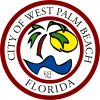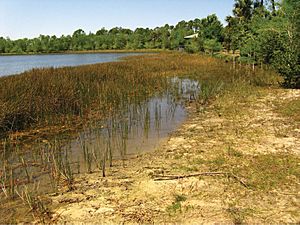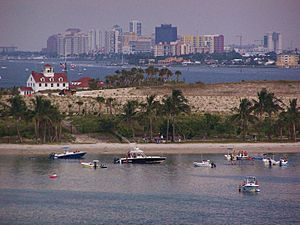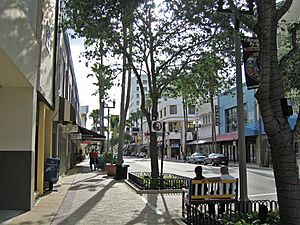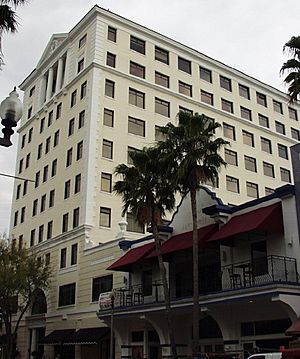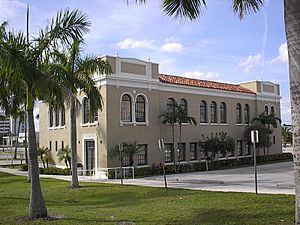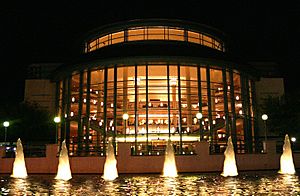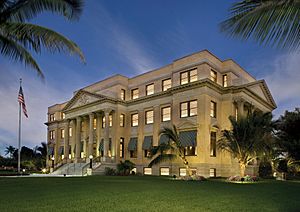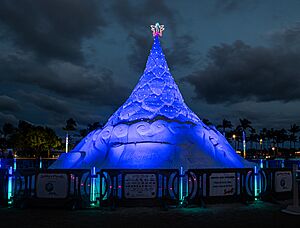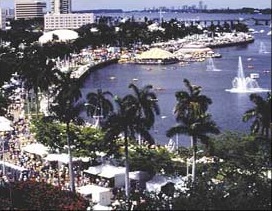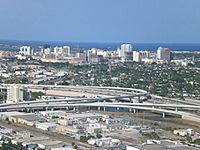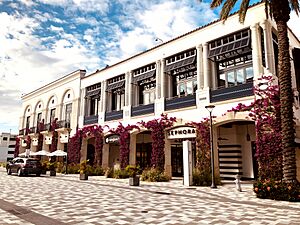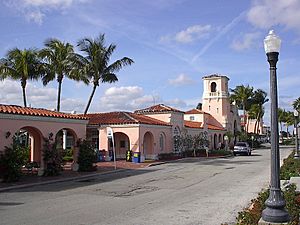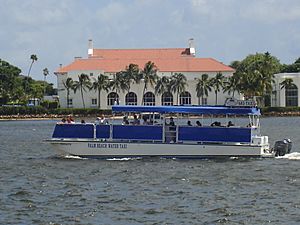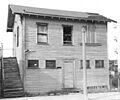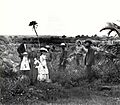West Palm Beach, Florida facts for kids
Quick facts for kids
West Palm Beach, Florida
|
|||
|---|---|---|---|

West Palm Beach skyline
|
|||
|
|||
| Nickname(s):
Orchid City, West Palm, WPB
|
|||
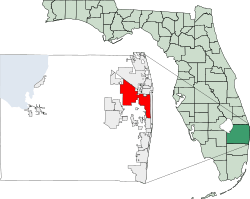
Location in Palm Beach County and the state of Florida
|
|||
| Country | |||
| State | |||
| County | Palm Beach | ||
| Settled (Lake Worth Country Settlement) | c. 1884 | ||
| Platted (West Palm Beach Settlement) | 1893 | ||
| Incorporated (Town of West Palm Beach) | November 5, 1894 | ||
| Incorporated (City of West Palm Beach) | July 21, 1903 | ||
| Named for | Location west of Palm Beach | ||
| Government | |||
| • Type | Mayor–Commission | ||
| Area | |||
| • Total | 57.98 sq mi (150.18 km2) | ||
| • Land | 53.82 sq mi (139.39 km2) | ||
| • Water | 4.17 sq mi (10.79 km2) | ||
| Elevation | 13 ft (4 m) | ||
| Population
(2020)
|
|||
| • Total | 117,415 | ||
| • Estimate
(2022)
|
120,932 | ||
| • Rank | 239th in the United States 17th in Florida |
||
| • Density | 2,246.97/sq mi (867.58/km2) | ||
| Time zone | UTC−5 (EST) | ||
| • Summer (DST) | UTC−4 (EDT) | ||
| ZIP codes |
33401–33422
|
||
| Area code | 561, 728 | ||
| FIPS code | 12-76600 | ||
| GNIS feature ID | 0293097 | ||
West Palm Beach is a vibrant city in Palm Beach County, Florida, United States. It's the main city in the county and sits just west of Palm Beach. Palm Beach is a narrow island across the Lake Worth Lagoon.
West Palm Beach is the biggest city in Palm Beach County. In 2020, about 117,415 people lived there. It's also a key part of the larger Miami metropolitan area, which had over 6 million people in 2020. West Palm Beach is the oldest city in South Florida, becoming a city in November 1894, two years before Miami. It is about 68 miles (109 km) north of Downtown Miami.
Contents
- Discovering West Palm Beach's Past
- Understanding West Palm Beach's Environment
- Exploring West Palm Beach's Geography
- Understanding West Palm Beach's Population
- Education in West Palm Beach
- Economy of West Palm Beach
- Arts and Culture in West Palm Beach
- Sports in West Palm Beach
- Tourism and Fun in West Palm Beach
- Getting Around West Palm Beach
- Media in West Palm Beach
- Sister Cities
- Notable People from West Palm Beach
- Images for kids
- See also
Discovering West Palm Beach's Past
The history of South Florida began when Juan Ponce de León met native people in 1513. Europeans found many native groups living there. These included the Mayaimi near Lake Okeechobee and the Jaega and Ais people along the east coast. By 1763, when the English took control, most native people were gone due to war, slavery, or European diseases.
Later, other native groups from Alabama and Georgia moved into Florida. Europeans called them Creeks, but in Florida, they were known as the Seminole and Miccosukee Indians. The Seminoles fought with American settlers over land and protecting escaped slaves. They resisted being moved west of the Mississippi River. Three wars were fought between 1818 and 1858. By 1858, very few Seminoles remained in Florida.
The area that became West Palm Beach was settled in the late 1870s and 1880s. A few hundred people called it Lake Worth Country. These settlers came from different parts of the world. Families like the Potters and Lainharts became important business leaders. The first white settlers lived around Lake Worth, a freshwater lake named after Colonel William Jenkins Worth. Most settlers grew tropical fruits and vegetables to send north. By 1890, over 200 people lived along Lake Worth. The area had a hotel, a church, and a post office.
The city was planned by Henry Morrison Flagler in 1893. He wanted a community for workers of his grand hotels on the nearby island of Palm Beach. This happened when the Florida East Coast railroad arrived. Flagler bought the land for $45,000 from two settlers.
On November 5, 1894, 78 people met and voted to make West Palm Beach a town. This made it the first town in Dade County (now Miami-Dade County) and in South Florida. The town council quickly set building rules. Tents and shanties were replaced with stronger buildings. The city grew steadily in the 1890s and early 1900s. Most people worked in tourism or the fruit and vegetable trade. In 1909, Palm Beach County was created, and West Palm Beach became its county seat. A new courthouse opened in 1916. It is now a local history museum.
The city grew very fast in the 1920s during the Florida land boom. The population quadrupled from 1920 to 1927. Many of the city's famous buildings were built then. Flagler had planned for his Florida East Coast Railway to end in West Palm Beach. But after a big freeze, he extended the railroad to Miami instead.
The land boom was already slowing down when a big storm, the 1928 Okeechobee hurricane, hit the city in 1928. The 1930s were quiet, with slow growth and lower property values. The city recovered during World War II. Palm Beach Air Force Base was built, bringing many military people. The base was important for training and access to North Africa. During the war, German U-boats sank ships off the coast. Palm Beach had blackouts to hide from the U-boats at night.
The 1950s saw another population boom. Many soldiers who served nearby came back to live there. Also, air conditioning made living in the tropical climate more comfortable year-round. West Palm Beach became one of the fastest-growing areas in the 1950s. The city's boundaries expanded west and south. However, many residents still lived in a narrow area from south to north. Neighborhoods were separated by race, which caused problems that the city still works on today. Downtown, especially Clematis Street, was the main shopping area.
In the 1960s, Palm Beach County's first enclosed shopping mall, the Palm Beach Mall, and an indoor arena were built. These helped the city for a short time. But in the 1970s and 1980s, crime was a problem. Businesses and people moved away from downtown to the suburbs. By the early 1990s, downtown had many empty buildings and looked run-down.
Since the 1990s, things have improved. New developments like CityPlace and the restoration of old buildings on Clematis Street have brought downtown back to life. The city has also focused on improving historic neighborhoods like Northwood, Flamingo Park, and El Cid. Some areas still face challenges, but new projects are being completed. The Palm Beach Mall, which had closed, was redeveloped into the Palm Beach Fashion Outlets in 2014. The Brightline high-speed train service to Miami and Fort Lauderdale opened in 2018.
Key Moments in West Palm Beach History
- 1893: The town was planned on Lake Worth Lagoon.
- 1894: West Palm Beach became an official town.
- 1909: West Palm Beach became the county seat of the new Palm Beach County.
- 1920s: The city grew very fast during the Florida land boom.
- 1928: A major hurricane hit the city.
- World War II: Palm Beach Air Force Base was built, bringing many people.
- 1950s: The city's population boomed again, partly due to air conditioning.
- 1990s: Downtown began to be redeveloped and improved.
- 2014: Palm Beach Outlets opened.
- 2018: Brightline high-speed rail service started.
Understanding West Palm Beach's Environment
West Palm Beach Canal (C51)
The West Palm Beach Canal (C-51) project helps control floods and treat stormwater. It runs from West Palm Beach at Lake Worth to a water conservation area. The project aims to protect the city from floods.
This project also helps clean water and reduce freshwater going into Lake Worth Lagoon. It also provides more water for the Everglades and other users. The total cost of the West Palm Beach Canal (C51) project is estimated at $375.47 million.
Exploring West Palm Beach's Geography
West Palm Beach covers about 58.2 square miles (150.7 km2). Most of this is land, with about 3.1 square miles (8.0 km2) being water.
Because of large wetland areas to the west, the city grew mostly north and south. Until the 1960s, the city was long and narrow. Later, development expanded west with better access and drainage. The city's boundaries didn't expand much, except for the "Water Catchment Area." This empty area in the northwest is now called Grassy Waters. It serves as a reservoir for drinking water and a nature preserve.
Historic Neighborhoods and Communities
West Palm Beach has many historic neighborhoods, each with its own story. These areas show the city's growth and different architectural styles.
- Bel Air Historic District: Built from 1925 to 1935 for tradesmen and real estate sellers. It was once a pineapple plantation.
- Central Park: This area was part of the Estates of South Palm Beach. It became an exclusive neighborhood around 1919.
- El Cid: Known for its Mediterranean revival and mission-style homes. It was developed in the 1920s from old pineapple fields.
- Flamingo Park: Also a former pineapple plantation, this area was developed from 1921 to 1930. It sits on one of the highest coastal ridges.
- Grandview Heights: One of the city's oldest neighborhoods, built from 1910 to 1925. It features craftsman-style bungalows.
- Mango Promenade: This area became a historic district in 1995. It is located just south of Palm Beach Atlantic University.
- Northboro Park: Developed from 1923 to 1940, this area has custom homes for upper-middle-class professionals.
- Northwest: First settled in 1894, this was the city's main African-American community for many years. It has various architectural styles.
- Old Northwood Historic District: Developed during the city's real estate boom from 1920 to 1927. It features extravagant Mediterranean revival homes.
- Northwood Hills Historic District: Designated in 2003, this area has Mission Revival homes and a unique street layout.
- Prospect Park: This high-end neighborhood was developed from 1920 to 1935. It has many Mediterranean revival homes.
- West Northwood Historic District: Developed from 1925 to 1927, this area also features Mediterranean revival and mission-style homes.
West Palm Beach and Nearby Communities
West Palm Beach is surrounded by many other cities and towns. These areas are part of the larger urbanized region. Many people in these nearby places have a "West Palm Beach" address. Palm Beach County and West Palm Beach provide services to these areas.
Here are some key cities and their populations in the West Palm Beach urban area:
- Boca Raton (89,407)
- Boynton Beach (71,097)
- Delray Beach (64,072)
- Wellington (60,202)
- Jupiter (58,298)
- Palm Beach Gardens (50,699)
- Greenacres (38,696)
- Royal Palm Beach (36,306)
- Lake Worth Beach (36,000)
- Riviera Beach (33,263)
Tallest Buildings in West Palm Beach
West Palm Beach has many tall buildings that shape its skyline. Here are some of the tallest:
- One West Palm: 30 stories, 426 feet (130 m)
- 515 Fern: 25 stories, 404 feet (123 m)
- South Flagler House (2026): 28 stories, 373 feet (114 m)
- One Flagler: 25 stories, 365 feet (111 m)
- The Plaza: 32 stories, 331 feet (101 m)
West Palm Beach's Climate
West Palm Beach has a tropical rainforest climate. This means it's warm all year round. The average temperature in all months is above 64°F (18°C).
The city has a wet season from May to October. This time is hot and humid, with lots of rain and afternoon thunderstorms. Temperatures often reach 90°F (32°C). Hurricanes can also happen late in this season. In 2004 and 2005, Hurricanes Frances, Jeanne, and Wilma caused damage.
The dry season is from November to April. It's still warm, with temperatures often in the 80s°F (27-32°C). Cold fronts can sometimes bring cooler weather, but freezes are rare. The last freeze was in 2010.
Understanding West Palm Beach's Population
| Historical population | |||
|---|---|---|---|
| Census | Pop. | %± | |
| 1900 | 564 | — | |
| 1910 | 1,743 | 209.0% | |
| 1920 | 8,659 | 396.8% | |
| 1930 | 26,610 | 207.3% | |
| 1940 | 33,693 | 26.6% | |
| 1950 | 43,162 | 28.1% | |
| 1960 | 56,208 | 30.2% | |
| 1970 | 57,375 | 2.1% | |
| 1980 | 63,305 | 10.3% | |
| 1990 | 67,643 | 6.9% | |
| 2000 | 82,103 | 21.4% | |
| 2010 | 99,919 | 21.7% | |
| 2020 | 117,415 | 17.5% | |
| 2022 (est.) | 120,932 | 21.0% | |
| U.S. Decennial Census 1900–1970 1980 1990 2000 2010 2020 2022 |
|||
West Palm Beach has grown a lot over the years. In 1900, only 564 people lived there. By 2020, the population was 117,415. The city continues to grow.
The city is a mix of different cultures. In 2020, about 38.3% of the people were White (not Hispanic). About 24.6% were Hispanic or Latino, and 30.9% were Black or African American. Other groups, like Asian and Native American, also live in the city.
Most people in West Palm Beach speak English at home. However, many also speak Spanish or Haitian Creole. This shows the diverse backgrounds of the city's residents.
Education in West Palm Beach
Public Schools
Public schools in West Palm Beach are managed by the School District of Palm Beach County. This is one of the largest school districts in the United States.
There are 18 public elementary schools in the city or nearby areas. Some of these include Belvedere, Forest Hill, and Roosevelt Elementary. For middle school, students attend one of nine schools, such as Bak Middle School of the Arts or John F. Kennedy Middle School. There are also six public high schools, including Dreyfoos School of the Arts and Palm Beach Lakes.
Charter and Multi-level Schools
- Palm Beach Maritime Academy: Serves students from kindergarten to 10th grade, planning to expand to K-12.
- Gardens School Of Technology Arts: For students in kindergarten through 8th grade.
- University Preparatory Academy: Serves students from kindergarten through 3rd grade.
Private Schools
Many private schools are available in the area. Some well-known ones include:
- Cardinal Newman High School
- The King's Academy
- American Heritage School
- Palm Beach Day Academy
- Oxbridge Academy of the Palm Beaches
- Rosarian Academy
Colleges and Universities
The old Palm Beach Junior College building has been restored. It is now part of the Dreyfoos School of the Arts campus. It serves as a satellite building for Palm Beach State College.
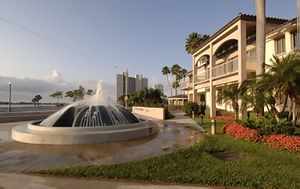
Palm Beach Atlantic University (PBAU) is a private Christian university. It has about 3,200 students and is located downtown. PBAU offers nursing and pharmacy programs.
Keiser University has a campus in West Palm Beach. It offers many different degrees. Other private schools include Lincoln College of Technology and Florida Culinary Institute.
Libraries
The Mandel Public Library of West Palm Beach serves the city. The new library opened in 2009 on Clematis Street. It offers books, performances, classes, and technology. The main branch of the Palm Beach County Library System is also in West Palm Beach.
Economy of West Palm Beach
Many companies have their headquarters in West Palm Beach. These include Affiliated Managers Group, Florida Public Utilities, and ION Media Networks. Other big employers are Pratt & Whitney, Aerojet Rocketdyne, and Sikorsky Aircraft.
Arts and Culture in West Palm Beach
West Palm Beach is a hub for arts and culture. There are many places to enjoy music, art, and history.
- Norton Museum of Art: This is the largest art museum in Florida. It has European, American, Chinese, and contemporary art.
- Kravis Center for the Performing Arts: Built in 1992, this center hosts concerts, dance shows, opera, and plays.
- Meyer Amphitheater: This outdoor amphitheater is on the waterfront. It was built where an old hotel used to be.
- Richard and Pat Johnson Palm Beach County History Museum: Located in the historic 1916 Court House. It tells the story of Palm Beach County.
- Palm Beach County Convention Center: A large complex downtown with exhibit halls and meeting rooms.
- Harriet Himmel Theater: A historic church that is now a multi-use theater. It's a cultural center in CityPlace.
Festivals and Shows
- SunFest: This is an annual music, art, and waterfront festival. It started in 1982 and draws over 275,000 people. Many famous artists have performed here.
- The Sandi Tree: A 35-foot tall sand sculpture decorated with lights. It's displayed downtown in December with a laser light show.
- Palm Beach International Film Festival: A film festival held in the area.
- Barrett-Jackson Collector Car Auction: A classic car auction held every March.
- Palm Beach Opera: An opera company that performs in the city.
Sports in West Palm Beach
West Palm Beach does not have its own major professional sports teams. However, teams like the Florida Panthers (hockey), Miami Marlins (baseball), Miami Dolphins (football), and Miami Heat (basketball) play in nearby cities.
Spring Training Baseball
West Palm Beach is a popular spot for baseball spring training.
- The Ballpark of the Palm Beaches opened in 2017. It hosts the Houston Astros and Washington Nationals.
- The Miami Marlins and St. Louis Cardinals train in nearby Jupiter at Roger Dean Stadium.
- In the past, West Palm Beach hosted teams like the St. Louis Browns and Philadelphia Athletics.
College Sports
- Palm Beach Atlantic University competes in NCAA Division II for basketball, baseball, and soccer.
- Florida Atlantic University's sports teams play in nearby Boca Raton. They compete at the highest NCAA level.
- Keiser University competes at the NAIA level.
Other Sports
- Professional Golf: The PGA National Resort & Spa in Palm Beach Gardens hosts the PGA Tour Honda Classic.
- Polo and Equestrian: The Palm Beach Polo and Country Club has many polo fields. The Palm Beach International Equestrian Center hosts major equestrian events.
- Tennis: The Delray Beach International Tennis Championships takes place annually in Delray Beach.
- Croquet: The National Croquet Center has 12 lawns, making it the largest croquet facility in the world.
- BMX Racing: Okeeheelee park has a famous BMX race track.
Tourism and Fun in West Palm Beach
West Palm Beach offers many attractions and activities for visitors and residents.
- Palm Beach Zoo at Dreher Park
- Rapids Water Park
- South Florida Science Museum
- Lion Country Safari
- International Polo Club Palm Beach
- National Croquet Center
- Trump International Golf Club (West Palm Beach)
Shopping Areas
- Clematis Street: This is West Palm Beach's historic "main street." It has shops and hosts "Clematis by Night" with live music.
- CityPlace: Opened in 2000, CityPlace has nightclubs, restaurants, and shops. It also has homes and apartments.
- Palm Beach Outlets: Opened in 2014 on the site of the old Palm Beach Mall. It has over 130 stores.
- Antique Row: A shopping area along Dixie Highway known for its antique shops.
- Northwood Village: A historic commercial area north of downtown. It's now promoted as an arts district.
Getting Around West Palm Beach
Air Travel
The city is served by Palm Beach International Airport (PBI). It's located just outside the city limits. In 2014, over 6.5 million passengers used PBI.
Biking
West Palm Beach is a great city for biking. It has flat terrain and early paved streets. A bike share program, SkyBike, started in 2015. The city plans to add more bike lanes downtown.
Highways
- U.S. 1 runs through the city's downtown.
- Interstate 95 goes through the city from north to south. It has exits for West Palm Beach and the airport.
- Florida's Turnpike is further west, connecting to suburbs like Royal Palm Beach.
- State Road 80 runs east-west from I-95.
Train Travel
- Amtrak has daily long-distance trains that stop in West Palm Beach. These trains go north and south to Miami.
- Tri-Rail is a commuter rail system. It serves the city from a historic station. Tri-Rail goes north to Mangonia Park and south to Miami.
- Brightline offers higher-speed passenger service to Miami and Fort Lauderdale. Service started in 2018.
- Freight trains from CSX Transportation and the Florida East Coast Railway also serve the city.
Other Transportation
- Trolley: A free downtown trolley helps people get around. It connects Clematis, City Place, the Tri-Rail Station, and Palm Beach Outlets.
- Bus: Greyhound Lines offers bus service from the train station. Palm Tran is the local bus service for Palm Beach County.
- Port: The Port of Palm Beach is on the city's northern edge. It's a busy port for shipping goods and has small cruise lines.
- Water Taxi: Water transportation is available on the waterfront. It connects downtown, Sailfish Marina, and Peanut Island.
Media in West Palm Beach
Newspapers
- The Palm Beach Post: This is the main daily newspaper for West Palm Beach and Palm Beach County. It's owned by Gannett.
- Palm Beach Daily News: Also owned by Gannett, this paper covers the town of Palm Beach.
- South Florida Sun-Sentinel: Based in Fort Lauderdale, it covers parts of Southern Palm Beach County.
- New Times Broward-Palm Beach: An alternative weekly publication.
- WPB Magazine: A quarterly magazine about West Palm Beach.
Radio and Television
West Palm Beach is a significant market for radio and television. Many local stations are available, along with stations from the Miami/Fort Lauderdale area.
Sister Cities
West Palm Beach has three sister cities:
Notable People from West Palm Beach
Many famous people have lived in or are from West Palm Beach.
- Tori Amos, singer-songwriter
- Ottis Anderson, NFL player, Super Bowl XXV MVP
- Bob Barker, TV game show host
- Scottie Barnes, professional basketball player
- Jimmy Buffett, singer and entertainer
- Glenn Close, actress
- John Collins, professional basketball player
- Bob Cousy, basketball Hall of Famer
- Phil Dawson, NFL placekicker
- Alexander W. Dreyfoos, Jr., entrepreneur and philanthropist
- Heath Evans, NFL fullback
- George Hamilton, actor
- John Havlicek, basketball Hall of Famer
- Devin Hester, NFL player
- Michael Jordan, basketball Hall of Famer
- Brooks Koepka, professional golfer
- Joey Kramer, Aerosmith drummer
- Larry the Cable Guy, comedian
- AJ McLean, from the Backstreet Boys
- Jim Palmer, baseball Hall of Famer
- James Patterson, author
- Burt Reynolds, actor
- Serena Williams, professional tennis player
- Venus Williams, professional tennis player
- Yanni, composer
Images for kids
-
Panoramic view of West Palm Beach, North Palm Beach and Lake Worth, 1915
See also
 In Spanish: West Palm Beach para niños
In Spanish: West Palm Beach para niños


